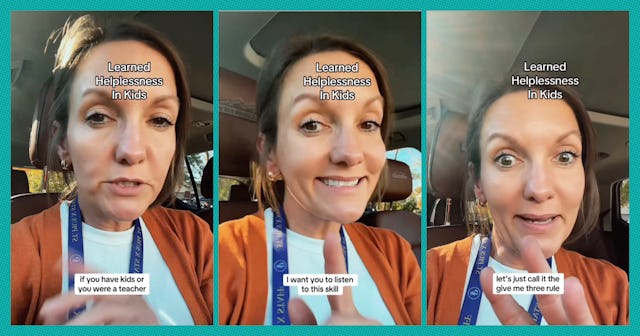Use This Mom’s Method To Combat Learned Helplessness In Your Kids
All you have to say is, “Give me three.”

“I can’t.” “It’s too hard.” “I just don’t know how.” If these are phrases are among your child’s most frequently used, they might be experiencing learned helplessness.
Learned helplessness occurs when someone adopts the belief that they’ll always be unsuccessful in solving a problem. Fortunately, anything learned can be unlearned, and Colleen Borgert has a helpful tip for parents to combat learned helplessness in kids.
Borgert is a mom and teacher who goes by @mrs._colleen_b on Instagram. She recently posted a Reel sharing how she deals with learned helplessness in her classroom, and her own home.
First off, Borgert asked parents and teachers to recognize that, yes, adults have a hand in this problem.
“We as adults are guilty of granting this learned helplessness to our kids. We’re not the only reason that they have it, but we are a big part,” she explained.
So, what do we do? Well, Borgert offered a tip she calls the “Give me three” method.
Borgert explained that one day, she was folding laundry and asked her son to come help. He complained that he didn’t know how, and when she encouraged him to help anyway, he asked her to show him how to do it. She began to show him, but then stopped herself.
“I stopped myself, and I looked at him, dead in his eyeballs, and I said, ‘Show me three times. And if you can’t get it after the third time, then I will show you how to do it,’” she said.
Kids asking for help before bothering to try on their own can contribute to the cycle of learned helplessness. Borgert’s method encourages kids to make a brave attempt, or three, first.
“Ultimately I know he knows how to do it or how to attempt to get it done, and the attempt is important, too,” Borgert explained.
Many commenters were in favor of Borgert’s method.
“When a student asks me how to do something, I always ask them to show me what they’ve already tried that didn’t work — if they’ve attempted nothing, I can’t help,” one user wrote.
“I am adding it helps our memory to make larger connections by experiencing the ‘mistake’ and finding more relevant changes to solve problem,” another said. “Fitting the drawer. Finding a single shirt in a group. Love this.”
However, some voiced that they felt the lack of assistance was unnecessarily stressful for learning kids.
“I don’t understand why u wouldn’t show him once, and have him then do it 3x. It’s still learning and giving him experience doing it on his own,” one user wrote
“This technique isn’t for new skills or skills that require a scaffolding technique,” Borgert responded. “This is for when [they] know how to accomplish something. He knows how to do it. He just didn’t want to do it.”
There’s definitely a time and place for this method. But, next time you find yourself spelling out the same word you’ve spelled a hundred times before, you know what to do.